Entries Tagged as '2010 Tyler'
Our task of the day was located at the Marston Marsh Reserve, to the south of City Centre. In order to get onto the reserve, Tom had to drive our van on a bumpy dirt path. Once we got on to the marsh, we split into two groups. The task of the first group was to remove rotting fence posts from the periphery of the marshland. During the summer, the marsh hosts several cows that keep the level of the grass down to a manageable level. Because these cows are graciously loaned by surrounding farm owners, the groundskeeper of the marsh needed to ensure that they would not escape the marsh and become sad, lost cows. I volunteered for the second group. Our task was to install a bench for the park goers. We decided to place the bench facing a small stream that runs through the marsh. First, we had to remove several branches from the area in order to make the bench accessible. Then we determined where the columns of the bench would be placed, and began digging.
Using a spade, I began digging a hole approximately one and a half feet deep. The layer of topsoil was easily removed and discarded to the side. However, the bedrock below the marsh soon proved to be extremely difficult to dig through. My accomplices used a spear shaped iron tool as leverage to separate the bedrock, which was heavily compressed into the soil. Then, I would use the spade to break up and separate the bedrock from the soil further. The rocks were difficult to remove using the spade, so I often had to remove and discard them by hand. I repeated this process several times, occasionally causing sparks from the spade hitting the bedrock. Des joked that I was lucky that there wasn’t much gas under the marsh.
Luckily, the bedrock gave way to softer clay, and we were able to insert the columns of the bench into the ground. Then, we dug two ditches that were perpendicular to the columns that had been placed into the ground. These were much more shallow than the depth that the columns needed, but we needed enough depth on the side of the columns so that side bars could be placed on the front and back of the bench. These sidebars would be buried underneath the ground, in order to make the bench too difficult to remove for any of the vandals that frequent the marsh.
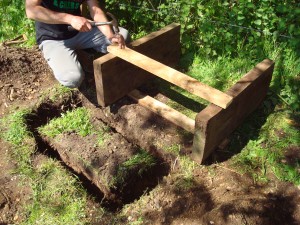
A view of the ditch, and the side bars that made our bench invincible
After nailing the sidebars into the column, we placed the base of the bench back into the ditch. A support block was placed on the inside of each column, and each block was held to the column by a large gauge bolt. Using a twist drill bit, we drilled a hole for the bolt through the side of the column and the support block. Two holes were drilled on each side of the column and block, and were attached using the bolts. Then, we attached the seat of the bench to the support blocks. The seat comprised of two oak boards, which were secured onto the support blocks by first using a drill bit to make a hole, and then securing the oak boards to each support block using a large gauge bolt. After all of the bolts were secured using a washer plate and two nuts, I used a hammer to beat down the threads of each bolt, thereby preventing any thieves from removing the nuts and deconstructing the bench. Because the bench was constructed using only oak, and bolted instead of using nails, we were confident that any thieves attempting theft of the bench would give up out of frustration.
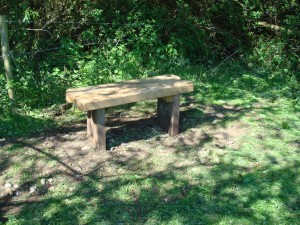
The finished bench
My palms were fairly bruised and sore from using the spade to break the bedrock, but I was satisfied that park goers would enjoy our creation for years to come. I learned that a well-maintained fence must supervise cows, for fear that they escape. I also discovered that the landscape of a marsh may look soft and lush, but the ground beneath may be tough to break through. But the most valuable lesson of the day was learning how to theft-proof a bench in a public park.
Date: 3/5/11
Time: 930 to 1330
Hours: 6 / Total: 18
Supervisor: Debbie Murray
Tags: 2010 Tyler
I woke up at eight in the morning, well prepared for my day of volunteering with the BTCV. My bag was packed with sunscreen and a water bottle, and I grabbed my bus pass to head off to City Centre. I dropped by the Tesco on Westlegate for a sarnie before heading up the hill past the John Lewis, and walked towards the BTCV office.

The field near our ivy removal task.
Our task for the day was the removal of ivy in a strip of forested land, between a housing development and a large empty field, in the vicinity of Taverham and Drayton. The large amount of ivy growth in the canopy of the forest was to be severed at the trunk of each tree. There was some debate as to whether this task would be helpful to our other conservation efforts. One volunteer argued that because birds and other animals feed on the berries that the ivy produce and use the ivy growth as a habitat, the removal of the ivy would be harmful to the wildlife in the area. However, BTCV’s funding is contingent on completing tasks for the local council, and removal of ivy was just one of these objectives. So volunteers who questioned the purpose of the ivy removal decided to keep a characteristically British “stiff upper lip” and not complain about the task once we had undertaken it. The council’s stated purpose in requesting this task was to lower the risk of trees blowing over and potentially damaging houses, due to the additional stress that the ivy’s presence would place on the trees during windy conditions.

Approximately the area where ivy was cut on each tree trunk. I'm not actually cutting the ivy in this picture, but if I was I would be wearing a glove on my left hand.
We cut the vines surrounding the trunk of each tree with a forestry tool called a billhook. The billhook is used with a swift, swinging motion to cut directly through the ivy vines. Because of risk inherent in using tools such as a billhook, all of the volunteers wore gloves on the hand opposite to the billhook. Wearing a glove with the hand holding the billhook was problematic, because it could easily slip out and cause injury. Therefore, it was best to use a bare hand to hold the billhook while cutting the ivy. We had to be sure to remove a clearly defined area, because it would be difficult for other volunteers to tell which trees had vines removed if they were only cut and not removed as well. For each tree, any vines in an area fully encircling the tree trunk were removed.
After a few hours of vine removal, we took a tea break. Compared to the first time I volunteered, the other group members were much more willing to ask me why I was in the England, as well as life in the United States. I was pretty anxious when I first volunteered at BTCV, but I could tell that the volunteers were open minded and accepting of outsiders. I also asked many of the volunteers why they had given their time to BTCV. Many of the regular volunteers were unemployed, and told me that the social atmosphere of BTCV and the presence of many other unemployed workers gave them a sense of camaraderie in working to overcome common obstacles. Many of the unemployed volunteers also stated that they felt that the conservation efforts were a positive use of their time, and that they wanted to contribute to the community, as opposed to simply collecting benefits and staying at home. Also, many of the volunteers pointed out that the experience and references would be useful on their CV, and would help them to stand out from other job applicants when the economy improved. There were also a few volunteers who were not regulars, and didn’t socialize with the group during tea break. I don’t want to speculate, but its possible that some of the volunteers were completing mandated community service programs.
There were a few more trees that needed vine removal, so after tea we got back to work. The forested strip became more overgrown with thorns and brush as we travelled further from where we started. We had to trim the thorns using our loppers, which are similar to pruning shears but are also useful for trimming small tree branches. We were able to access most of the trees in the overgrown area and complete our task. After finishing the ivy removal in the area we started, we looked for other forested areas to check for ivy as well. However, there were no more vines to be found past the area that we had completed. As a group, we took a hike down to Marriott’s Way, an abandoned railroad right of way named for William Marriott, manager of the Midland and Great Northern Railway. One of the volunteers pointed out to me the small wooden pathways that we were walking over, and explained that one of the tasks that the local council contracts out to us was the construction and maintenance of that path and others like it. After gathering our belongings, we headed back to the BTCV lodge in City Centre.

Lots of ivy everywhere.
The most interesting aspect of the task that day was that we probably would not even considered ivy removal if BTCV’s funding was directly tied to the goal. There was some debate about the usefulness of the task, and whether it would harm the wildlife in that area, but in the end we all decided to cooperate in order to secure this funding. I personally was more than willing to remove the ivy for this funding, but I can see why the volunteers with experience in forestry and ecology would see this activity as counterproductive to the goal of increased conservation. It was rewarding to listen to many of the reasons that BTCVers gave for spending their time volunteering. I also gained an understanding of BTCV as a useful social group for people who want to contribute to the improvement of Norwich as unemployed individuals, regardless of their socioeconomic circumstances.
Date: 28/4/11
Time: 930 – 1500
Hours: 5.5 / Total Hours: 12
Supervisor: Debbie Murray
Tags: 2010 Tyler
On a warm and sunny Thursday morning, I made my way to the Norwich office of the British Trust for Conservation Volunteers (BTCV for short). I left my flat for the bus stop with plenty of time to arrive, but somehow I managed to get lost among the twisting and windy streets to the south of City Centre. Finally, I gave up and called the office to ask for directions. Tom was kind enough to find me a few yards away from the pathway that lead to the entrance, which was hidden behind thick brush. After signing a few forms, I made my way through the office to introduce myself to the other volunteers.
BTCV is a voluntary organization focused on conservation and education about environmental sustainability. Volunteers help to maintain parkland for public enjoyment, as well as working on landscaping tasks that raise funds for conservation efforts. In addition to working with volunteers who have learning disabilities, the trust offers career placement and volunteer opportunities for youth and the long-term unemployed.
At 930, ten other volunteers got into a van and headed toward the western end of the Bowthorpe housing subdivision, not far from the UEA village. Our task was based in a marshland that was purchased for preservation by the property developer, as a condition for the construction of the development. That day, our objective was to heather a fence along the edge of the marshland. Heathering is the creation of a fence in a decorative and aesthetically pleasing manner, achieved by weaving long branches in and out of stakes that are set in the ground. Our work wasn’t a conservation task, but was in exchange for funding from the local council that will be used to support our conservation efforts.
To start, we used a staking ram to drive the stakes into the ground, spaced at even intervals. We had to use the staking ram with two volunteers, one on each side. This was mainly to prevent injury, but also helped us keep the stakes at a ninety-degree angle with the ground. At one point, the stakes were unevenly spaced, so we had to remove them and place them again. At times, it would be difficult to ram the stakes into the ground, because the stake would start to shift to one side or would hit a rock. In any of these cases, the stake had to be removed and replaced. After completing the staking, we decided to take a break for tea and eat our lunches. My supervisor Debbie and I had engaging conversations on the relationship between economics and ecology during these tea breaks. Also, the MP for Norwich South, Simon Wright, stopped by to join us for tea and talk to us about our conservation efforts.
After the staking was completed, we used long branches to heather the fence. To start, one volunteer would hold a branch at one end, and the other volunteer would weave the branches in and out of the stakes. If the volunteer holding the branch let go of it, the heather would fall. Shane, a more experienced volunteer, took the job of weaving the branches in and out of the stakes, while I held the end of each branch to support it. Successive branches were be added at each stake, fitting under the previous branch. Then, all of the branches that had been added were weaved in and out of the stakes. After three or four branches, the tension created would hold the heather up on its own. Heathering was much easier than driving the stakes into the ground, which required a great deal of exertion and coordinated teamwork. However, an endeavor that seemed painless soon became painful. I quickly learned how to identify stinging nettle, after putting my hand through a nettle plant while lifting a branch off the ground. However, my recovery was rapid and I was back at work within a minute.
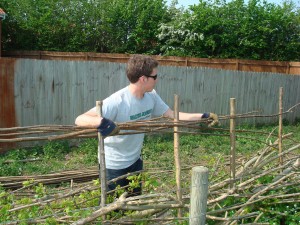
Holding the existing heathering while Shane gets more branches.
The heather fence that we created extended about 100 metres, with a gap in the middle to make the marshland accessible to the community. At 1600, with an afternoon of work completed and a little bit of sunburn, we headed back to the BTCV lodge in the van. When I first arrived at BTCV, I had an assumption of conservation work as an abstract concept of action and tasks that are intended to help and preserve wildlife. I didn’t understand that a lot of our tasks were undertaken solely for the purpose of maintaining our other conservation efforts financially. Before I volunteered, I didn’t fully appreciate the degree to which Norwich and the areas surrounding the city rely on volunteers for the maintenance of its public spaces. On the surface, it seemed that our task was merely a means to an end. However, the sense of community and purpose that it gave the members of our group, volunteers with a wide range of abilities and life experiences, was an admirable goal in itself.
Date: 21/4/11
Time: 930 – 1600
Hours: 6.5 / Total: 6.5
Supervisor: Debbie Murray
Tags: 2010 Tyler
September 21st, 2010 · 2 Comments
Of all of the pubs which I frequented during my one month stay, the Rising Sun was my favorite. Now, you might ask why I would be interested in going to this tiny pub with limited outdoor seating, and frankly food which was lacking in sophistication and cooking skills. Seriously, Dave got frozen peas with his Fish n’ Chips. And the answer is, of all of the pubs I went to during a football match, the clientele at the Rising Sun were the only ones that I saw as being truely interested in the games at hand. And I think that the smaller atmosphere of this pub actually facilitated this.
Tonites game was Tottenham Hotspur versus Arsenal. From the reactions of the pubgoers to each of Arsenal’s four goals against the Spurs, they were vastly Arsenal fans. When an Arsenal player was fouled as he brought the ball through the penalty box, the fans were outraged. And the exitement of the sucessful penalty kick got the entire pub cheering afterwards.
During the second fifteen minute half of the extended time period, the fans would also cheer as a group whenever an Arsenal player gained possession of the ball or stole it from a Spurs player. For example, if the Arsenal player avoided losing posession, a large contingent of the pubgoers in front of the bar would exclaim say “OHHHHHH!” in unison. This actually reminds me quite a bit of the reaction towards gaining possession during football games at the sports bar I go to back home. At many of the other bars, it seemed that the football matches on the flatscreens were more of an afterthought, and most of the customers were ignoring them. However, that may be because Arsenal wasn’t playing in those games.
If you want good food and an excellent selection of beers and spirits, go to the Jack Horner. The food is quite a bit more expensive than the other pubs, but the Fish and Chips are some of the best that I have had throughout my stay in London (and that is many a fish n’ chips). I would also recommend trying the Fullers ESB. Another favorite pub of mine was the court, mainly because they served Everards Tiger, an ale with light coffee notes.
Tags: 2010 Tyler · Pubs · Uncategorized
September 21st, 2010 · No Comments
Of all of the theater events we attended, 39 Steps was my favorite. The slapstick nature of it kept me engaged, even though I had no idea what was going on during most parts of the play. Also, the actors were able to change character quite easily, and they had to with only four actors on stage. Of course, these characters were completely static, and this play was certainly not the most thought provoking. Being on Piccadilly Circus, the Criterion Theatre was clearly one of the more touristy of the theatres in London, so obviously they were not trying to cater to an erudite British crowd.
The Habit of Art was far to confusing for me, I never really understood the purpose of the group of characters sitting off to the right side of the stage. Most of these characters had extremely minor roles, which was unnecessary to the progression of the plot in my opinion. It was also difficult to tell if the dialogue on center stage was the discussion of the production, or a “play within a play”. It probably didn’t help that I was near-comatose at the time, and this overt intellectualism was not welcome at the time. I think I would have been able to appreciate this play more if it was a matinee and I had been more awake at the time.
The Merry Wives of Windsor was the most difficult for me to sit through. I was pretty jetlagged at the time, and it didn’t help that my grasp of Elizabethan English was already tenuous. Also, standing in a crowd for two and a half hours after having walked over London, mye legs were killing me at that point. However, I though that the recurring innuendo on latin lessons was funny, especially considering my experience in high school latin was very masochistic as well.
Tags: 2010 Tyler · Theatre · Uncategorized
September 21st, 2010 · No Comments
One commonality connecting our visits to diverse religious institutions was a certain level of decorum expected of visitors, which was of course implicitly observed by worshippers. In each of these places, visitors could not take any pictures, but there were many other customs which we were asked to observe in respect to each of these places of worship.
For example, in both the Mandir and the Mosque, visitors were expected to take off their shoes before passing beyond the entrance of each of the respective buildings. I feel like I should have asked about this custom while at the Mandir; I understand the justification for this observance of this custom at the Mosque exists because Islamic culture values emphasizing cleanliness. Is it the same justification at the Mandir? And of course, we were expected to not eat pork or smoke before going to the Mosque or Synagogue, due to the respective dietary laws of Islam and Judaism.
It was very interesting to hear about the application of Sharia law in the UK. Most of the Sharia, although observed by faithful Muslims, is not legally codified in the UK. The parts which are legally binding mostly involve marital contracts and business contracts between consenting parties. So, like Christians and Jews (whose religious marriages are recognised by the state), Muslims are allowed to enter these contracts at their behest. It is always interesting to hear the argument that Sharia law should not be allowed in the Western world, despite the fact that these obligations don’t impact anyone except the Muslims who are parties to them. Maybe, if they don’t like Islamic culture being practiced in the West, they should give up other customs which were imported from the Islamic world after the Crusades. Like bathing.
Back what was supposed to be the topic of this blogpost. One major difference between St. Paul’s cathedral and Westminster Abbey on one hand, and the Mandir, Mosque, and Synagogue on the other hand, was that there were burial tombs and cryps in each of the Anglican sites of worship, but none in the Hindu, Muslim, or Jewish sites. But, after thinking about it more, this has to do more with the age of the buildings; the Anglican sites were hundreds of years older than the Muslim, Jewish or Hindu sites.
Tags: 2010 Tyler · Churches and Cathedrals · Uncategorized
September 21st, 2010 · 2 Comments
With sunny skies and a temperature of 20 degrees, yesterday was the perfect day to get out of the museums and visit Kew Gardens. To get to the Kew Gardens tube stop, you take the Northern line to Embankment, and transfer to the westbound District line trains terminating at Richmond. The ride from Embankment to Kew Gardens took a little over 30 minutes, so plan to spend at least 2 hours at the gardens to make the trip worthwhile. After leaving the Kew Gardens tube stop, you must take a brisk five minute walk down a tree lined street, to the Victoria gate of the Royal Botanical Gardens.
The entrance fee at the gates is £13.50 for adults, but £11.50 if you bring your student ID. At the entrance, I saw several people showing cards and being allowed quick entrance without buying tickets. Later, when I spoke to a guide I inquired what this card entailed, and the guide explained that many of the denizens of the surrounding area had purchased membership in order to enjoy the privilage of visiting the park for free whenever it was open. Even though the neighborhood by the tube stop was quite scenic and had lots of open public space, it became apparent to me that the ammenities that the park provided made a full membership worthwhile if you lived in the surrounding area.
As you walk down the path from the entrance, you are greeted by the sight of a diverse selection of trees from arround the world, neatly arranged in groves to the sides of the path. Along the way, I spotted what is believed to be the oldest tree in Kew Gardens, a Sweet Chestnut tree thought to have been planted in the early 18th century. The Sweet Chestnut tree is thought to have been introduced from Southern Europe by homesick Romans who were known to use the chestnuts to produce flour and other edibles.
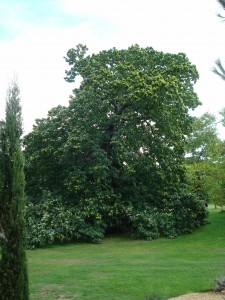
I decided to walk to the southern end of the Gardens, toward the Japanese landscape garden, with a “Chokusi-Mon” replica in the center. Chokusi-Mon means “Gateway to the Imperial Messenger” in Japanese, and this temple was a replica of one in Kyoto.

There was also a peacock just chillin’ to the side of the path, next to a bush! Some of the other visitors, who seeing from their accents were British, passed by and made clicking noises to get the attention of the bird. They were not very sucessful, but it reminded me of Kate Fox’s discussion about how Brits like to talk to pets and animals for as a coping mechanism for their social dis-ease.

Finally, I visited the Princess of Wales Conservatory, which contained several plant selections from several climate zones, including a Tropical Rainforest, Desert, Tropical and Temperate Ferns, and an Orchid room! There were live butterflies in several of the rooms, but I couldn’t take any pictures because I used all of the spare memory on my camera. If you are ever in London again, and want to escape the bustle of the city, go to Kew Gardens!

Tags: 2010 Tyler · Uncategorized
September 20th, 2010 · 1 Comment
The Royal Crescent, located on the outskirts of the town of Bath, is an excellent example of the Georgian style of architecture common in housing built during the 18th century. Designed by John Wood the Younger, the Crescent is similar to much of the architecture in Bloomsbury is that the windows become shorter as you move further up the building. Another Georgian feature are the the Ionic columns between each of the windows, throughout the facade.
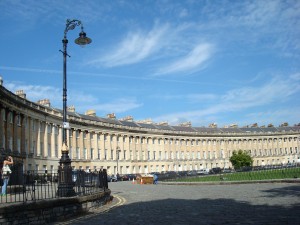
The Royal Crescent was built between 1767 and 1774, and was formerly home to British royalty such as Prince Fredrick, Duke of York and Albany. Unfortunately, the Crescent sustained some damage during the World War II bombing raids, as the Ministry of Defense is not located far from Bath. However, this damage is not apparent to the splendid condition that the building is currently in.
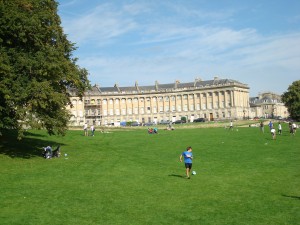
One of the most breathtaking views of the Crescent is looking upward from the bottom of the hill, looking past the expansive park above. There was a game of pick up football happening on the far side of the field, and closer to the Crescent park goers were sunbathing and picnicking.
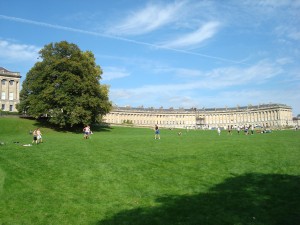
Bath was by far the most scenic town I have ever been to, and I found it hard to put my camera down considering how aesthetically pleasing the sights were.


Tags: 2010 Tyler · Uncategorized
September 20th, 2010 · No Comments
The Victoria and Albert Museum in South Kensington is unique in that instead of focusing on one style or type of art, the exhibits at the Victoria and Albert include diverse forms of decoration. I use the term decoration broadly because the museum is essentially a collection of decorative items and artifacts, including porcelain, tapestry, and other furnishings, mostly from the 16th century onward. Also featured are exhibits on sculpture, but that is for another blog.
The museum bills itself as “the greatest museum of art and design”, and in that respect it fulfills its mission. It would be overly simplistic to say that the Victoria and Albert is simply a collection of the conspicuous consumption of the well heeled before the 20th century, but not completely off the mark. The luxurious possessions which comprised the museum included silver and gold gilded tea sets, large tapestries, and detailed porcelain. For example, there was an exhibit on Chinoiserie, which despite its name, was not specifically a Chinese craft. In fact, Chinoserie was a combination of Japanese, Chinese, and Indian motifs designed and produced in Britain in the mid 18th century.
A section which interested me in particular was the exhibit containing artwork and artifacts involving Johnathan Tyers, an ambitious entreprenuer from the 18th century. Tyers really loved George Friedrich Handel, so much that he commissioned a statue of him for placement in Spring Gardens near Vauxhall.
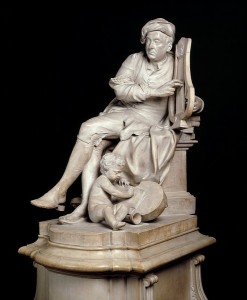
Taken from (http://collections.vam.ac.uk/item/O34256/statue-handel/), by Louis Francois Roubiliac.
This statue features the composer playing the lyre of Orpheus, a mythical figure whose music calmed even the most savage beast. Tyers wanted this statue to be placed in the heart of the Gardens, possibly as symbolism of his campaign to convert the gardens from its earlier seediness. Today, I stopped by the gardens, a five minute walk from the Vauxhaul station on the Victoria line, hoping to see the product of Tyers’ toils. But unfortunately the previous gardens had been razed in order to build housing, and when that housing had been demolished the gardens were not restored to their previous glory. The park had clearly reverted to its seedier nature, judging by the sight of a homeless man passed out on a park bench holding a bottle of whisky…
Tags: 2010 Tyler · Museums · Uncategorized
September 9th, 2010 · 4 Comments
In addition to its collection of British royal armour, the White Tower Museum at the Tower of London had an incredible collection of armour and weaponry from countries including China, Japan, Germany, and Russia. Of particular interest to me was a helmet and a dagger, both of Indian origin. The dagger, also known as a Katar, is decorated with a scene which includes the Hindu deities Krishna (playing the flute) and Vishnu. Both serve a cerimonial purpose and were not meant for use in battle.
What suprised me when reading the plaque next to these items was the was the lack of detail in describing how these items were obtained. The plaque in question simply stated that the helmet and dagger were given as a diplomatic gift to the East India Company, who then donated it to be exhibited in British museums such as the White Tower. Without explaining the influence of the East India Company in colonial India, little context is given to the aquisition of these “diplomatic gifts”.
First, the East India Company was known to use violence to achieve its trade monopoly on the Indian Subcontinent. In many cases, the company hired local mercenaries, also known as Sepoys (although I dont remember if the term was used in the description of the Rebellion of 1857 in White Teeth). This divide and conquer strategy, pitting the local population against each other, allowed the company to profit extensively through exploitative trade and working conditions as well as consolidate power throughout the subcontinent.
Also, many of the so called treaties that were formed between the East India Company and the local ruling classes were later violated by the company, so to term any gifts from the local nobility as “diplomatic” is to completely whitewash the lack of concern that the company held for these agreements. These treaties were often formed under duress or fear of violence, so the local ruling class likely had very good reason to give the invaders valuable gifts that they would normally retain for posterity.
I asked a curator in the museum if he had more specific information on how these two treasures were obtained by the East India Company, but unfortunately he was unable to tell me anything about the object besides it being on loan from another museum in the UK. He also interestingly stated that the items were donated to a museum because the company had no use for them.
Do you think that describing these items as diplomatic gifts is appropriate?
Tags: 2010 Tyler · Museums · readings


















